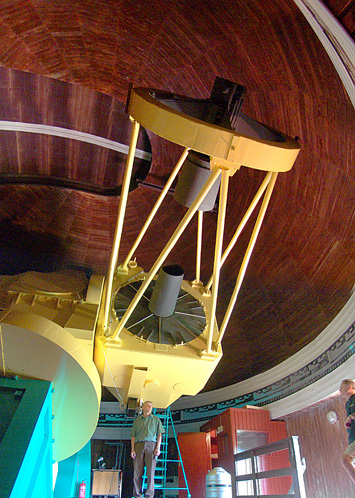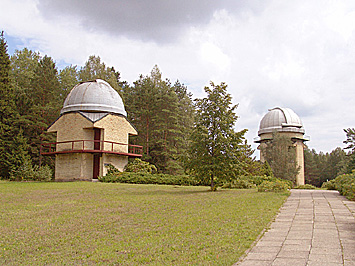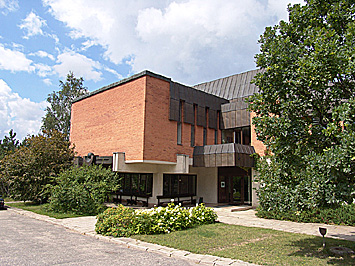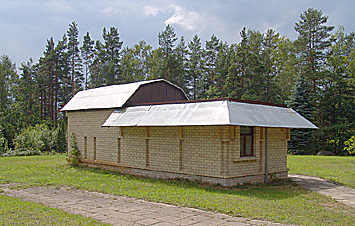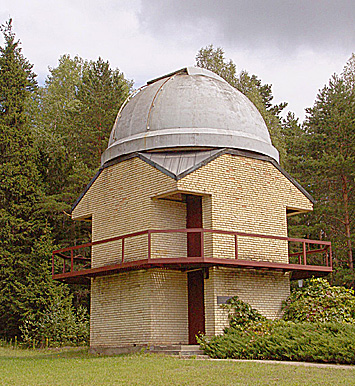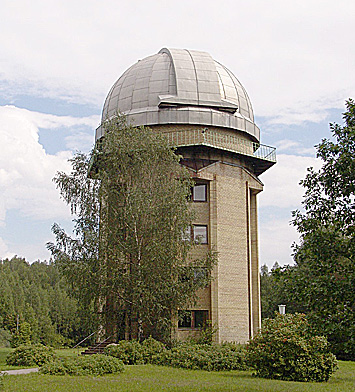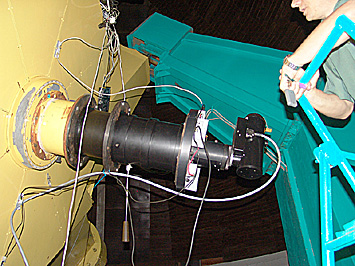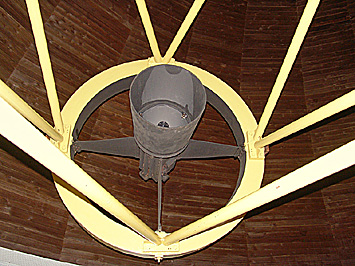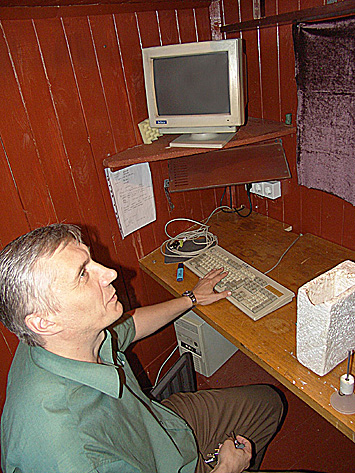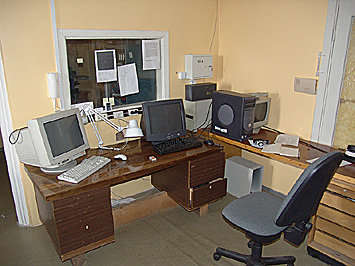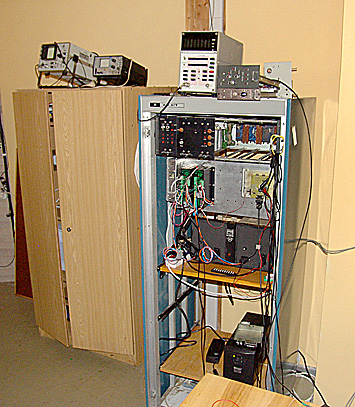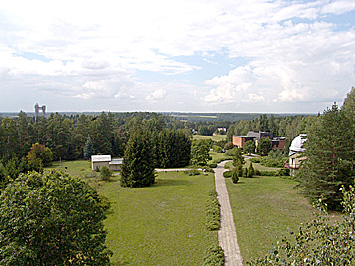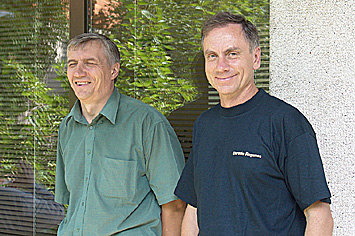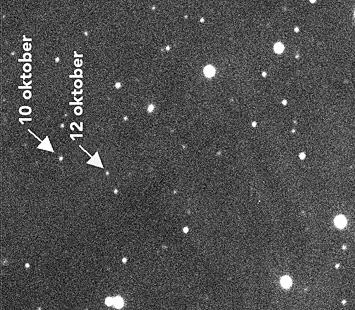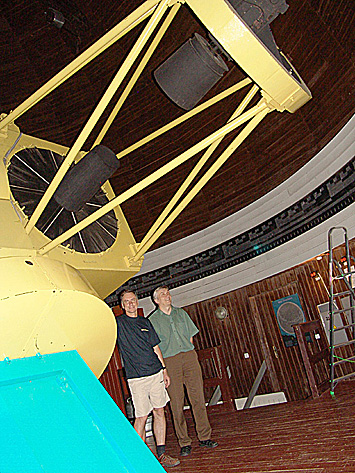In Europe’s darkest spot, right in the middle of the Labanoriu National Park north of Vilnius in Lithuania you’ll find the Astronomical Observatory of Moletai (Moletu Astronomijos Observatorija, MAO). Its two telescopes, one with a 63-centimetre mirror and the larger 165-centimetre reflector, are the biggest in Lithuania.
The large telescope at the Astronomical Observatory of Moletai was built at the Leningrad Technical University and was completed in 1989. This was at the time of the collapse of the Soviet Union, so the times were worrying even for telescope builders. The university actually built three similar telescopes, but the one that was going to Ukraine was only half-finished before the Soviet Union collapsed, and the mirror of the second one was stuck in the new Russia with the mechanism stuck in Maidanako in Uzbekistan (and none of them wants to relinquish them). Consequently, MAO has the only working telescope.
The large telescope is equipped with a Cassegrain-mounted 1300 x 1300 pixel CCD camera, cooled with liquid nitrogen. On the floor is a dewar with liquid nitrogen (light grey, metallic bottle).
Laurent Cassegrain was a French inventor who, in 1672 found an ingenious way to shorten reflector telescopes. The telescope has a hyperbolic primary mirror at the very back (below the black shutter in the image above) and a secondary, convex hyperbolic mirror located in the middle of the telescope (see the image of the secondary. below) which sends the image back through a hole in the primary, to the camera located in the middle of this hole (see the image of the camera, below). Thus, the optical path is folded twice, shortening the telescope considerably, compared to the old Newtonian design (https://en.wikipedia.org/wiki/Newtonian_telescope). Mirror telephoto lenses for cameras are designed the same way.
The reason for cooling the camera’s CCD array is that the silicon itself generates noise in the form of random electrons that create havoc in the photosensitive cells. The colder the material, the fewer disturbing electrons are generated. The ideal would have been to cool it with liquid helium, but liquid nitrogen is not that bad. In addition, it is much cheaper (costs less than beer).
It may seem impossible that one could make advanced observations in the middle of Europe, but the fact is that MAO could actually verify the discovery of the solar system’s tenth planet Eris (formerly Xena) in 2005, a not too bright object in the Kuiper Belt, outside Pluto’s orbit. (The truth is, however, that most Lithuanian astronomers now work at the Nordic Observatory at La Palma at the Canary Islands, as there are fewer clouds there.)
Great Conditions
The conditions for astronomical work in Labanoriu National Park are among the best in Central Europe, with the city of Vilnius 80 kilometres south and no other major light sources in other directions (mainly Belarus, which is not so developed). On average, the observatory has 100 days of good seeing per year, with 10 days of resolution better than 1 milli-radian. On entering the park there are warning signs that you should turn off all headlights when approaching the observatory. The conditions were actually much better when the telescope was built, during the Soviet era, as Eastern Europe was much darker then. Today, it’s not as good, yet quite impressive. Being a big-city dweller, getting out into the absolute darkness, one stumbles around for at least 20 minutes before one can even orient oneself properly. The astronomers, who are used to this, are laughing and having a good time in general.
The telescope cost about one million rubles way back when, and was fully paid to the Soviet Union, thus fully belonging to the Lithuanian state at the collapse of the Soviet Union. Since the ruble was not convertible in the western currency it is difficult to estimate the real cost, but a similar modern telescope would cost about 10 million USD today.
(Side track: Life was harder for the radio astronomers in Irbene, Latvia. Irbene was, until the Soviet collapse, a secret, closed military city inhabited by some 3,000 people. One member of each family was working at the spy antennas, a kind of early Echelon. Irbene is a collection of three satellite dishes, the largest of which has a diameter of 32 meters, which were used to eavesdrop on western telecom satellites. After long negotiations, with the help of, among others, the people of Moletai and the Swedish Råö Observatory, the antennas were sold to the Latvian State for civilian, astronomical use instead of being blown up, as the Russians would have preferred. Before the Russians left, they stole everything available, including quite a few copper cables that the astronomers had to replace later. However, the antennas work fine today. The Virac radio telescope’s own website: http://virac.eu/en/home/ The author’s page about Irbene: http://www.qedata.se/e_js_lettlandsgalleri.htm. Well, that was one big side track.)
Remotely Controlled over the Internet
The telescope and camera are completely computer-controlled and run remotely from Vilnius over the Internet. Why do you do that? The telescope is used by the astronomical faculty of Vilnius University, and it’s much more convenient to just click on a sky coordinate at the desk in the university, or perhaps from your bedside table at home, than bump away for hours on the not very well-kempt roads in the national park. Still, the telescope does not work without an operator because the liquid nitrogen must be filled every six hours, someone has to open the sliding roof in the evening, and shut it if it starts to rain, etc.
Guided Tour
The observatory area is magnificent with its two big domes and the smaller, old telescope close by. In addition, there are many holy stones from Pagan times. (More side-tracking: Lithuania was the last country in Europe to be christened, in 1386 to be exact. Until then, Lithuanians kept their Pagan religion, something similar to the Nordic Aesir cult, but with slightly different gods and spiced up with fire worship. A number of holy stones remain from those days. The observatory area has several of them, displaying different kinds of cavities that have probably been altars or stood at some cult site. The strangest one has several holes and is called the Devil’s footprint.)
The administrative building has a hotel for astronomers. We are in the middle of nowhere, so one can’t just go to a hotel ”in town” to sleep. And remember you are sleeping in the daytime. The wall has a magnificent sundial that shows both the time of day and the season, by pointing to the signs of the zodiac as well.
The first observatory building with its sliding roof (shown closed), was built in 1970. There wasn’t a lot of money then, so a simple brick house had to do, with a regular amateur telescope up in the attic, which turned into an observation platform when the roof slid away.
The 63-centimeter telescope was built in 1974 with a mirror purchased in the United States back in 1938, which had been in cold storage since then. There were simply no means in the young, free Lithuania in the thirties to build a telescope.
The 165-centimeter telescope was assembled and saw first light in 1991, even though the telescope mechanism and the mirror were already manufactured in 1989. It was then Northern Europe’s largest telescope.
Zooming in on the camera. The focal plane is somewhere inside the yellow tube. Then there is a long black focal length extender (4 virtual meters) and at the far right is the vertical black can of liquid nitrogen, inside which CCD array is located. One simply lifts the lid on top and pours in more nitrogen when the previous liquid has boiled away. It may look a bit sloppy with the wires taped here and there, but this will not affect picture quality. Also, it works. They do not change instruments that often.
The secondary mirror, that is, the hyperbolical mirror that reflects the image from the primary mirror back through the hole in the middle of said primary mirror. Note the black cross at the very back, the mount, which gives all the bright stars these beautiful (irritating) Disney beams (astronomers call them ”coma”). Unfortunately it has to be there, in the middle of the optical path. In reality, everything is completely black, I just upped my exposure to show all the detail.
This is what it looks like in the operator’s hut, under the dome by the telescope. It has a guidance computer and a heater. An operator has to sit here when the telescope is being guided and calibrated, and is required to top up the liquid nitrogen during the observations. It gets rather chilly up there during the winter nights. The door to the observation dome is light-proof so that the light in the operator’s hut does not disturb the observation.
The control room. The computer at the right controls the CCD camera and the one to the left aims the telescope. Aiming is done by displaying a star map on the screen of the aiming computer, clicking on it and looking at the CCD camera image to the right to verify the telescope is pointed properly. The telescope is then re-aimed by again clicking on the star map and making sure the camera image follows suit. The computers are regular, standard Windows machines. Those times when you needed special machines and unusual operating systems in science are long gone.
The room behind the control room houses the drive electronics. The rack contains Russian homebrew electronics used to aim and turn the telescope. At the bottom, though, is an all-American uninterruptible power supply from APC-Schneider, to make sure everything survives a power failure. Please note the not-so-modern Russian oscilloscopes on the top of the left-hand cupboard. Next to them are other instruments that can be hooked up to the telescope for making various measurements.
There is, for example a red-shift meter that can measure the distance to an observed star with a known spectrum by determining the amount of red-shift. The more red-shift, the farther away it is, because objects far from the Earth move away from us faster than nearby ones. The red-shift is simply the Doppler effect of light, exactly the same phenomenon as the falling tone of an ambulance moving away from the listener.
The other instrument is a spectrometer used to determine a star’s spectrum. The properties of the spectrum give a hint of the star’s age and type. Older stars have used up most of their hydrogen and fused it into helium, or have gone even further and changed their helium into heavier elements. All this is revealed in the spectrum, that is, the colour of the star. After the star has converted all its material into iron, the fusion process ceases to work and the star crashes in on itself to become a white dwarf.
You get a fantastic view of the surroundings from the viewing balcony of the 165-cm telescope. The structure in the horizon to the left is the nearby Etno-Cosmological Museum (https://www.teknikaliteter.se/2017/11/15/etnokosmologiska-museet/). The oldest observatory building is at the bottom left and part of the 63-cm telescope is visible to the right. We are in the middle of a national park so there aren’t any houses or farmsteads nearby. When the night comes, it is absolutely pitch dark. The astronomers love it. The only disturbing lights at the night-time horizon are the border crossings into Belarus, which Lithuania keeps well lit-up all the time (or the immigration policy would turn into chaos fairly quickly). Belarus itself is not very developed and by that, isn’t much of a disturbance light-wise. Well, it was even better during Soviet times when the area was very backward. The nearest big city is Vilnius 80 kilometres away, so it doesn’t make much of a disturbance either.
We thank the comet hunter Dr. Kazimeras Cernis (left, discovererer of 25 comets) and the astro-physicist Gediminas Beresnevicius (right) for showing us around their workplace.
Dwarf Planet Eris (ex. Xena)
The Solar system no longer has nine planets. Only eight. Pluto (diameter 2300 km) was demoted to the status of dwarf planet, and was joined by a few new ones: Ceres (diameter 975 km) and Eris (diameter 2326 km), of which Eris is the larger. Some others are Ixion, Quaoar, Orcus and Sedna. Pluto travels mostly in the vast emptiness of the Solar system, whereas Eris and most of the other dwarf planets inhabit the so called Kuiper belt, an area filled with ice-rubble and various abandoned planetary rubbish that didn’t manage to concentrate into planets when the Solar system condensed more than 5 billion years ago.
Eris isn’t very bright, because it is merely a dirty snowball, travelling outside the orbit of Pluto. Anyway, here are two images of the planet that the comet-hunters gave me. I put them on top of each other, and adjusted a bit for varying aim and zoom factors. The images are captured two days apart, to allow the dwarf planet to move a bit between exposures. Although the CCD camera is so sensitive it can count single photons, it had to work for four minutes to make proper exposures of Eris.
The images were made by Kazimeras Cernis using the 165-cm telescope CCD. You can easily see how the planet has travelled against the static background.
- Object: Eris (ex. Xena) near the constellation Cetus
- Magnitude: 18.7
- Dates: October 10 and 12, 2005
- Exposure duration: 4 minutes at f/3,1
- Opening angle: 0.2 x 0.2 degrees
There are no other well-known stars in the image. The faintest stars are around magnitude 20.
Technical Data of the 165-cm Telescope
The telescope under the dome. The dome could not be opened during my daytime visit, because the CCD camera was cooled and ready for the coming night. Thus, it was sensitive to daylight, even though the shutter, the black sector sheets hiding the primary mirror resting inside the yellow base, was closed.
Note the binary code on the wall above the astronomers’ heads. It represents the turning angle of the telescope, and is made of aluminium foil on a black background. In the olden days it was scanned by some optical sensors and used for aiming the telescope, but it wasn’t very exact and has been replaced by a modern encoder. Those of technical wit might wonder why the code on the wall is standard binary and not Gray code? The author also pondered this question, and came to the conclusion that it was probably this, i.e. the risk of binary instabilities when transiting between two binary values, plus the almost insurmountable task if you wanted to increase the accuracy, keep all the foil clean, or just simply calibrate everything, which caused the system to be abandoned and replaced with modern electronics.
- 165 cm reflector telescope with aperture 3.1 according to the Cassegrain principle.
- The mirror is not parabolic but hyperbolic, to give wide-field effect.
- The mirror is re-aluminized every 5 years and has built-in heating loops to eliminate fog and frost.
- Opening angle: 10 mrad
- Built at Leningrad University in 1989
- First light in Moletai 1991
- Camera: 1300 x 1300 pixels LNG-cooled CCD
- Weight: 2 tons
- The dome is made of wood with sheet metal covering
- The telescope is aimed by computer, using the point-and-click-method in a digital star directory
The green part is the equatorial mount. One of the axes of rotation, the one that protrudes from the floor, is aimed at the Pole Star, so you only have to turn around this axis to counter the rotation of the Earth. The second, horisontal shaft is used to find the right elevation in the sky.
An other type of mounting, azimuthal mounting, looking a bit like a cannon lavette, means having to aim the telescope in two axes and compensating for the Earth’s rotation in both axes at all times, which is more difficult. However, the mounting is simpler and really the only option for heavier telescopes.
The mirror is re-aluminized every five years. A front-facing mirror of this magnitude cannot be polished or washed if it becomes dirty, because it is coated with an atom-thin layer of aluminium, which is applied in vacuum. If you touch the surface layer, it will be worn off. Washing the mirror is almost out of the question. How to safely get the 500 kilo lump down five floors, is another question. And then up again, without touching the front face.
Further Reading
Astronomy in Lithuania: http://www.astro.lt/al-e.html
MAO: http://mao.tfai.vu.lt/sci/en/news/ https://en.wikipedia.org/wiki/Mol%C4%97tai_Astronomical_Observatory
Vilnius University, 440 years old, is one of Europe’s oldest: https://www.vu.lt/en
Eris, the dwarf planet: https://en.wikipedia.org/wiki/Eris_(dwarf_planet)
Swedish language version: https://www.teknikaliteter.se/2018/01/02/yrke-kometjagare/
About Lithuania
If you, like the author, were taught in school a hundred years ago that Lithuania is a Soviet republic, and subsequently read all kinds of dirt in the media, you might think that Lithuania is a poor, miserable place with cracked houses, rusty railways and electron tube computers. Nothing could be further from the truth. After its independence in 1991, the economy has sky-rocketed with such speed that the good life has long surpassed Sweden.
The range of goods in the shops is considerably better and the product diversity is greater than in Sweden. Swedes are poor at mobile usage in comparison, and the healthcare system does things with computers that we can only dream of. And the food, yes, at least the undersigned keeps dreaming of it all the time.
Check it out for yourself: http://www.qedata.se/e_js_litauiskt_galleri_flik_intro.htm

